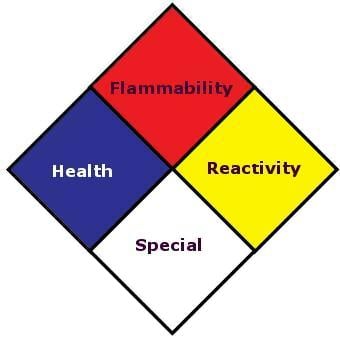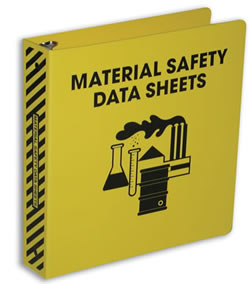Introduction To Right To Know/Hazard Communication

This on-line quiz is designed to provide basic education to Cirrus Aircraft employees on the importance and benefits of properly recognizing and safely working with hazardous materials.
This quiz does not cover all aspects of the Right To Know Standard, nor should it be used as the only method of understanding and applying this standard.
- 1.
Key ComponentsThe most important component of the entire Right-To-Know program is the employee training and information program. The Right-To-Know Act of 1988 (29 CFR 1910.1200) requires that this training be given at the time of initial assignment and whenever a new hazard is introduced into the workplace. The following elements are key components of this training:
- The nature of hazards posed by chemicals in the workplace
- Instruction on work practices, personal protective equipment, and any special procedures to be followed in an emergency
- Measures that employees can take to protect themselves from chemical hazards
- What material safety data sheets (MSDS) are and how to use them
- An explanation of the institution's RTK/ Hazard Communication policy, including information on labeling chemicals
- The requirements of the RTK law
- What Products are NOT Covered?
- Any chemical which can do harm to your body
- The damage to you body is depandant on your length of exposure. On an MSDS sheet, you will find the PEL or Permissable Exposure Limit. This maximum level that you can be exposed to a given substance
- Some chemicals have an acute effect, which means that a person will typically have an immediate reaction to the substance
- Other chemicals have a chronic effect that occur are long term or multiple exposure. The overall effect to the body may not manifest it self for week,months or even years.
- Chemicals being transported in state as part of a shipment in interstate or intrastate commerce.
- Chemicals covered by the Federal Atomic Energy Act and the Federal Resource Conservation and Recovery Act.
- Alcoholic beverages and articles intended for personal consumption.
- Consumer products that are used in the workplace in the same manner as normal consumer use.
- A.
Acetone
- B.
Aspirin
- C.
PTM&W
- D.
All of the above
Correct Answer
B. AspirinExplanation
Aspirin is excluded from the Right-to-Know Law because it is considered a consumer product that is used in the workplace in the same manner as normal consumer use. The Right-to-Know Law covers chemicals that pose hazards in the workplace, but since aspirin is typically used for personal consumption and not for occupational purposes, it is not included in the law's requirements for training and information.Rate this question:
- 2.
MSDS An important element described in the law for chemical safety awareness is the Material Safety Data Sheet (MSDS). Like the label, the MSDS provides you with information regarding the hazards associated with a chemical. However, the information provided is much more comprehensive. It is important to consult an MSDS before introducing a new chemical to your work area or when questions arise while working with hazardous substances. Prepared by its manufacturer, an MSDS provides information to help you understand the intrinsic hazards of the chemical including:
- physical and chemical properties
- stability and reactivity information
- health hazard information
- acute and chronic effects of exposure
- permissible exposure limits
- required personal protective equipment
- Employees should be trained and comfortable in using a computer to acess an MSDS
- You may also request copies of MSDS from your supervisor or through your facilities Eviromental, Health and Safety (EH&S) specialist By law, If you do not receive a MSDS within 5 days of a written request, you may refuse to work with that chemical until the information is received. ( Please see your facility EH&S specials if you have questions or concerns)Under the RTK law, all of our facilites are responsible for providing the following information?
- A.
Initial RTK Training
- B.
An MSDS on Site
- C.
Labeled Containers
- D.
All of the Above
- 3.
Labels IIt is important to be able to identify simple hazards that are associated with chemical products. Labels can help provide this critical information. This rule should apply to all technicians and administrative employees. Manufacture Labels Chemical manufacturers provide pertinent labeling information on their original containers making them a good reference for information on chemical hazards. Labels on containers of purchased chemicals may include:
- The common name of the substance
- An appropriate hazard warning
- Proper handling, storage and emergency response information
- Blue indicates the health hazard.
- Red indicates the fire hazard.
- Yellow indicates the reactivity hazard.
- White gives special information such as water or oxidizer incompatibility.
- Corrosives: Destroy living tissue on contact
- Toxics: Hazardous to your health
- Flammables: Readily catch fire
- Reactives: React violently with materials in otherwise stable situations
- A.
Health Hazard
- B.
Water incompatibility hazard
- C.
Fire hazard
- D.
Reactivity hazard
Correct Answer
D. Reactivity hazardExplanation
The Higher The rating number, the more significant the hazardRate this question:
- 4.
The Minnesota Right-To-Know Act says that? Visit Minnesota Rule:https://www.revisor.leg.state.mn.us/rules/?id=5206.0200
- A.
Employees are responsible for learning everything there is to know about the hazardous materials in the workplace.
- B.
Employers must evaluate their workplaces for the existence of hazardous substances, harmful physical agents, and infectious agents and provide training and information to those employees covered under the act who are routinely exposed to those substances and agents
- C.
Putting labels on chemical containers is all that is necessary to be in compliance.
Correct Answer
B. Employers must evaluate their workplaces for the existence of hazardous substances, harmful physical agents, and infectious agents and provide training and information to those employees covered under the act who are routinely exposed to those substances and agentsExplanation
The Minnesota Right-To-Know Act requires employers to assess their workplaces for the presence of hazardous substances, harmful physical agents, and infectious agents. They are also obligated to provide training and information to employees who are regularly exposed to these substances and agents. Merely labeling chemical containers is not sufficient to comply with the act.Rate this question:
-
- 5.
If employees want to learn more about a hazardous material or chemical, the best information is found through?
- A.
Container labels only.
- B.
Material Safety Data Sheets (MSDS) only.
- C.
Labels and Material Safety Data Sheets only.
- D.
Labels, Material Safety Data Sheets, and the employer's RTK/Hazard Communication Program.
Correct Answer
D. Labels, Material Safety Data Sheets, and the employer's RTK/Hazard Communication Program.Explanation
The correct answer is Labels, Material Safety Data Sheets, and the employer's RTK/Hazard Communication Program. This is because employees need to have access to multiple sources of information to ensure they have a comprehensive understanding of the hazardous material or chemical. Container labels provide basic information, MSDS provides detailed information about the hazards and handling procedures, and the employer's RTK/Hazard Communication Program provides specific instructions and protocols for safe use and storage. Having access to all three sources ensures employees have the necessary knowledge to handle the hazardous material or chemical safely.Rate this question:
-
- 6.
We have a RTK/Hazard Communication Program in place at our company?
- A.
True
- B.
False
Correct Answer
A. TrueExplanation
The given answer is true because the statement indicates that the company has a RTK/Hazard Communication Program in place. This program is crucial for ensuring the safety and well-being of employees by providing information about hazardous chemicals in the workplace and how to handle them safely. Having such a program demonstrates the company's commitment to maintaining a safe work environment and complying with relevant regulations and standards.Rate this question:
-
- 7.
Every container that holds a potentially hazardous material must be labeled?
- A.
True
- B.
False
Correct Answer
A. TrueExplanation
Every container that holds a potentially hazardous material must be labeled to ensure the safety of individuals who come into contact with it. Labeling allows for proper identification and communication of the potential dangers associated with the material. It helps prevent accidents, mishandling, and facilitates appropriate emergency response in case of spills or leaks. Failing to label containers can lead to confusion, increased risk, and potential harm to individuals and the environment. Therefore, it is crucial to label all containers containing potentially hazardous materials.Rate this question:
-
- 8.
My employer is only required to supply Material Safety Data Sheets for materials which have a severe hazard?
- A.
True
- B.
False
Correct Answer
B. FalseExplanation
Employers are required to supply Material Safety Data Sheets (MSDS) for all hazardous materials, not just those with severe hazards. MSDS provide important information about the potential hazards of a material, including its physical and chemical properties, proper handling and storage procedures, and emergency response measures. This ensures that employees have access to necessary information to work safely with hazardous substances. Therefore, the correct answer is false.Rate this question:
-
- 9.
If I am unsure about the whether a material may be hazardous I should?
- A.
Try to work with the material as safely as possible
- B.
Put on extra layers of Personal Protective Equipment
- C.
Review the MSDS first and/or ask my supervisor for information on the potential hazard of the material
Correct Answer
C. Review the MSDS first and/or ask my supervisor for information on the potential hazard of the materialExplanation
When unsure about the potential hazard of a material, it is important to review the Material Safety Data Sheet (MSDS) first. The MSDS provides detailed information about the chemical composition, physical and health hazards, and safety precautions associated with the material. Additionally, seeking guidance from a supervisor is crucial as they may have additional knowledge or experience regarding the potential hazards of the material. This approach ensures that necessary precautions can be taken to work with the material safely and minimize any potential risks.Rate this question:
-
- 10.
Household chemicals are never as dangerous as the ones at work?
- A.
True
- B.
False
Correct Answer
B. FalseExplanation
This statement is false because household chemicals can be just as dangerous as the ones at work. Household chemicals like cleaning products, pesticides, and solvents can pose serious health risks if not handled properly. They can cause skin irritation, respiratory problems, and even poisoning if ingested or inhaled. Therefore, it is important to use caution and follow safety guidelines when handling any type of chemical, whether at home or in the workplace.Rate this question:
-
- 11.
The routes of entry into the body for chemical exposure employer is only required to supply Material Safety Data Sheets for potentially deadly materials I work with?
- A.
Inhalation
- B.
Ingestion
- C.
Absorbtion
- D.
All of the Above
Correct Answer
D. All of the AboveExplanation
The correct answer is "All of the Above." This means that all three routes of entry into the body for chemical exposure - inhalation, ingestion, and absorption - require the employer to supply Material Safety Data Sheets (MSDS) for potentially deadly materials. MSDS contain important information about the hazards, handling, and safety precautions associated with the chemicals, ensuring that employees are aware of the risks and can take appropriate measures to protect themselves.Rate this question:
-
- 12.
When and where can you encounter a hazardous chemical or material?
- A.
At Home
- B.
Anywhere, Anytime
- C.
At Work
Correct Answer
B. Anywhere, AnytimeExplanation
Hazardous chemicals or materials can be encountered anywhere and at any time, not just limited to specific locations such as home or workplace. This is because hazardous substances can be found in various settings, including public spaces, transportation, recreational areas, and even in natural environments. It is important to be aware of potential hazards and take necessary precautions regardless of the location or time.Rate this question:
-
- 13.
What does MSDS stand for?
- A.
Material Safety Description Sheet
- B.
Material Safety Dummy Sheet
- C.
Material Safety Data Sheet
- D.
Material Safety Data System
Correct Answer
C. Material Safety Data SheetExplanation
MSDS stands for Material Safety Data Sheet. This document provides detailed information about the potential hazards, handling, storage, and emergency procedures for a specific substance or product. It includes information on the composition, physical and chemical properties, toxicity, and safe handling practices. MSDSs are essential for ensuring the safety of workers and providing necessary information for emergency responders in case of accidents or spills.Rate this question:
-
- 14.
The Hazard Communication 29 CFR 1910.1200 code is known as the?
- A.
The OSHA Law
- B.
I Don't Have a Clue Law
- C.
Chemical Safety Suggestion Law
- D.
The Right To Know Law
Correct Answer
D. The Right To Know LawExplanation
The correct answer is "The Right To Know Law." The Hazard Communication 29 CFR 1910.1200 code, also known as the Right To Know Law, requires employers to inform employees about the hazardous chemicals they may be exposed to in the workplace. This law ensures that employees have the right to access information about the chemicals they work with and understand the associated hazards. It also mandates the use of safety data sheets (SDS) and proper labeling of hazardous substances to promote a safe working environment.Rate this question:
-
- 15.
Various chemicals at our facility can have an acute or chronic effect on the body. This means that an employee would see an immediate effect due to exposure or the effect would not show itself until months or years later.
- A.
True
- B.
False
Correct Answer
A. TrueExplanation
The statement explains that chemicals at the facility can have either an immediate effect or a delayed effect on the body. This implies that exposure to these chemicals can cause both acute and chronic health issues. Therefore, the answer "True" is correct as it aligns with the information provided.Rate this question:
-
D. All of the Above
The correct answer is "All of the Above". According to the information provided, under the RTK law, all facilities are responsible for providing initial RTK training, having an MSDS on site, and using labeled containers. This ensures that employees have the necessary information and resources to work safely with hazardous chemicals.
Rate this question:
Quiz Review Timeline +
Our quizzes are rigorously reviewed, monitored and continuously updated by our expert board to maintain accuracy, relevance, and timeliness.
-
Current Version
-
Mar 20, 2023Quiz Edited by
ProProfs Editorial Team -
Mar 27, 2009Quiz Created by
Usabrit
 Back to top
Back to top




